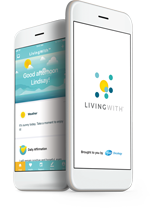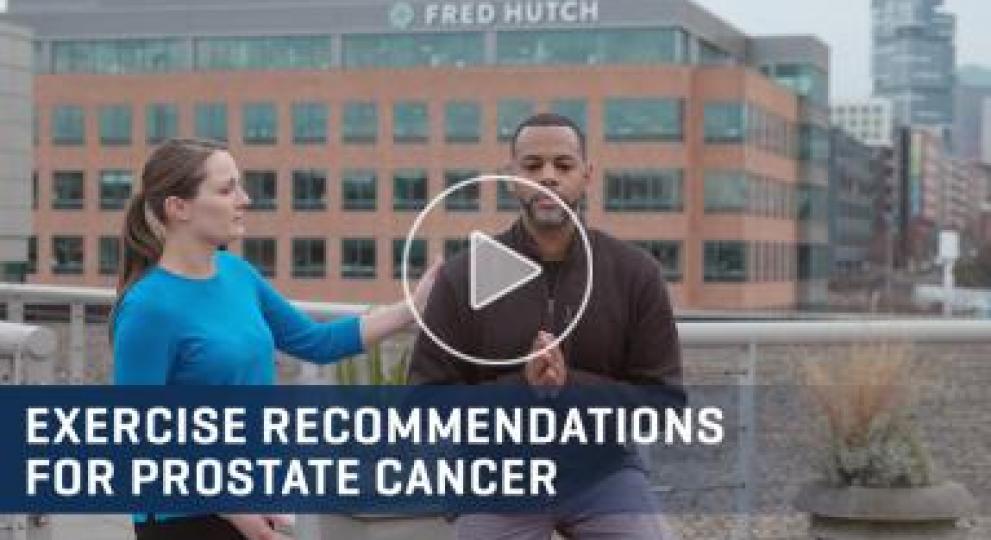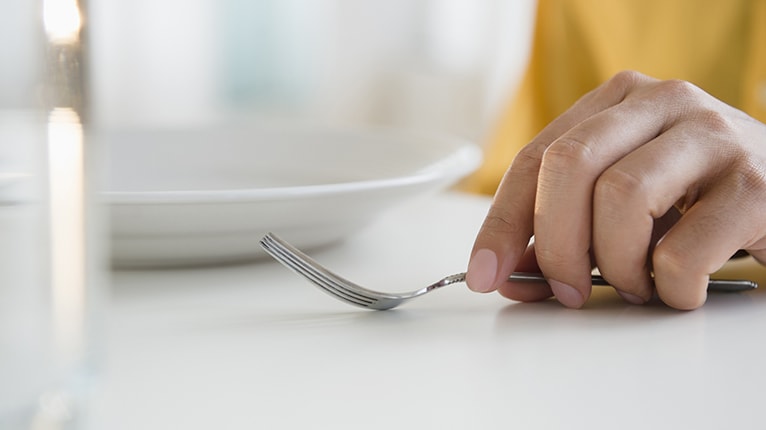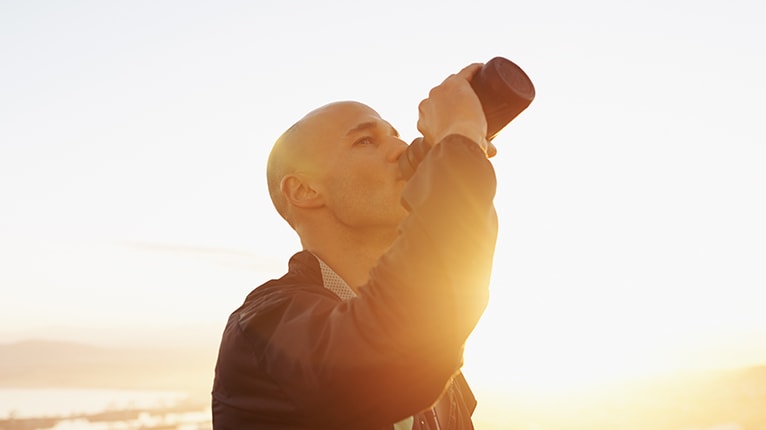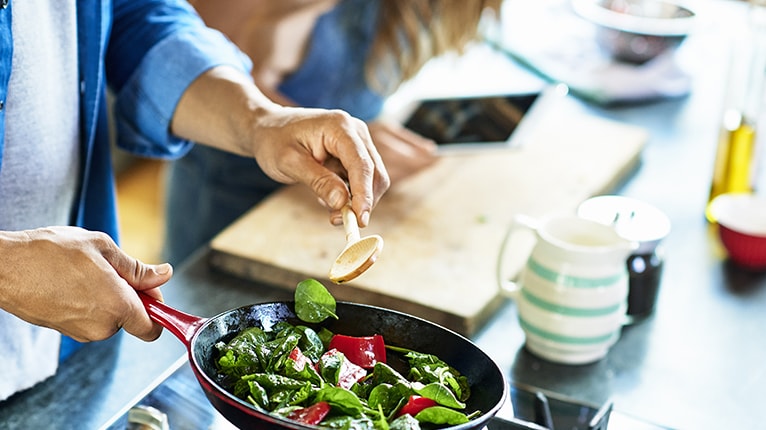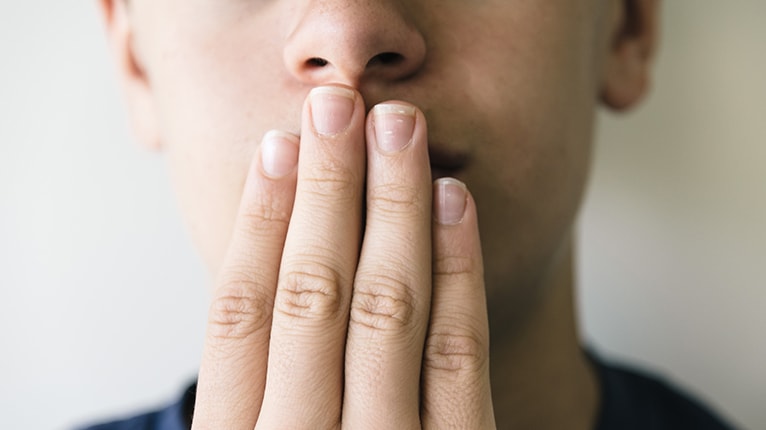Prostate Cancer Exercise Video
[music]
[Dr. Brady] We at Fred Hutch put together a series of exercises that can help people to develop a program, whether they're a beginner or they're already an advanced exerciser.
[Matt] Exercise can be for anyone, no matter what their ability, what their age, what their background is, there's a program for everyone out there.
[Dr. Cheng] The Fred Hutch has a number of excellent brochures to guide you through some of these exercises, but I would also encourage patients to talk with their doctors about how to incorporate them into their lifestyle.
[music]
[Matt] This exercise is the straight arm plank. This is going to be modified for more beginner version of this exercise.
So we are going to start by placing both palms on the table, we're going to step away from that table, and we're going to make a straight line with our back, and we're going to hold this plank position right here using our abdominal core.
Go ahead and try this one out here. We’re going to hold for 15 seconds, using your abdominal core to hold you in the position.
Breathing is important, so remember to breathe in and breathe out as you perform this exercise.
Remembering to keep good posture, straight through the back, focusing on that abdominal core. After 15 seconds, we're going to stand, and now we're going to move on to a more modified version, which is an intermediate version which is going to be using our elbows.
So again, using the table. We can also use the back of a couch, a chair, a bed, countertop.
We're going to put that weight through the elbows here, step back, keeping our back nice and straight, focusing that energy right on the abdominal core.
So again, go ahead and get in this position. Be on your toes a little bit more, straight through the back, head forward, remembering to breathe in, and breathe out, throughout this plank. 15 seconds is a good amount of time to start with.
Okay, and we stand – come forward, stand up – that was a really nice job, good form on that one.
[Man] Thank you.
[music]
[Matt] This exercise is a seated trunk twist. It’s an exercise for your abdominal core – very simple to do at home.
You're going to start by bringing your hands together…
You're going to rotate all the way one side and then rotate all the way back to the other side. Good.
Back to the side again.
To progress with this exercise, add a simple weight – a resistance ball, dumbbell, a weighted object. Rotate all the way one side…
…back to the next. Engaging those muscles of the abdominal core.
Excellent. Keep that ball tucked in tight towards you.
Good posture is important.
Keep that chest up.
Great job.
[music]
[Kelsey] Alright, so for the boat hold, seated boat hold, I'll have you sit on the edge of your chair, sitting up really tall…
I'll have you just lean back, right back, do not touch the edge of the chair.
Legs are going to be together. And then you're going to lift your legs up off the ground. It's very important to maintain steady breathing during this exercise.
This you'll hold for about 15 to 20 seconds, or whatever level you're at. For a modified version of this exercise…
I'll have you drop one leg down to the ground, starting with a single leg hold, and then alternating after…
…15 to 20 seconds – and alternate – and then, bringing back to the regular version of both legs out if you want to advance this…
…you're going to increase the leverage and straighten out your legs…
…for a much more advanced hold here. Making sure to keep breathing the whole time.
Really using your core here. Alright, nice job. Go ahead and bend your legs back down, and then you can
bring them down to the ground. Perfect.
[music]
[Matt] For the seated bicep curl, posture is very important. So, what you're going to focus on, is keeping your back straight, keeping your chest up, keeping your chin up as you do this exercise.
I'm going to give you these dumbbells, we're starting with a very light amount of weight. Elbows are going to be out to your side and pointing down…
arms to your side, bring your knees together. And we're going to have your palms facing forward.
Start with eight repetitions…
bringing the weight up and back down again. It's important to start with a low number of repetitions, such as 8, and increase gradually.
So eventually we're going to be increasing the amount of weight that you do. Good, very nice posture. Keep that chin up…
remember to breathe while you're performing these exercises. Excellent. Good job.
[Kelsey] Alright, so for the single arm row, you want to start with the weight in your right hand. Okay?
Ummm, you're going to take your right leg, place it out in front of you. Perfect.
Sitting up really tall, I'm going have you hinge forward at the waist. Perfect. This is to get your shoulders
over your knee, right – to increase the leverage.
Right arm nice and long on the side of your body.
…and you're going to bring…a little bit closer to your hip there. Perfect.
You're going to bring your elbow right up to the sky like you're starting a lawn mower and then all the way back down.
Great. Go ahead and do five more. Perfect, just like that.
Really working the back here…
…and our shoulder as well as the back of the arm. Exhaling as the weight comes up.
Inhaling as the weight goes back down.
Alright, one more, and I'll have you switch to the other side. Great! Alright, go ahead and bring your
right leg back in.
Switch the weight. Left leg out in front of you.
Right hand on the right knee. Sit up nice and tall again.
Hing forward at the waist. Left arm nice and long and left elbow up to the ceiling. Perfect, and back down. Great. Exhale as the weight comes up…
…Inhale as it comes down. Nice job.
Perfect. Ok, two more.
[music]
[Matt] For an advanced version of a push-up, we are going to use a chair. So what I'm going to have you do is come up close to the chair.
You’re going to grip the chair firmly on either arm, there, and we're going to walk your feet backwards, so we're going to really focus on keeping your spine neutral, tightening your core, and you are going to lower your body down to the chair, and you're going to push yourself back up off the chair.
As you approach the chair, you're inhaling. You're going to exhale as you push away from that chair.
Excellent. Good positioning.
Nice job.
Alright, good. Really focusing on keeping that neutral spine. Nice straight back, keep that core tight. Alright. Excellent.
[music]
[Kelsey] Alright, we're going to start with the single leg press. Go ahead and bring your right leg out in front of you…
…just a couple inches off the floor, and then you're going to bring your knee into your chest. Breathing in…
…as your knee comes into your chest and exhaling as you go out.
Now, of course, you do your other side for this exercise, but I'm going to show you a little bit harder modification.
We're going to bring some weights, or anything you might have at home, to make this a little harder. Rest them right on your thigh, maintaining good posture…
…you're going to go right back into that single leg press. Perfect. And you would do this also on your other leg as well.
Now for the hardest modification, if you're ready for this – I'll take the weights from you. We're going to do a chair stand. So go ahead and cross your arms over your chest…
…sitting up nice and tall, engaging your core, keeping your weight on your heels, I'll have you stand up. Perfect, and then all the way back down.
Nice. Good. Perfect.
[Matt] So this exercise is the standing calf raise. We do this on flat ground, very easy to perform at home, good exercise for the calf muscles.
We’re going to start by having a narrow base, so keep our feet together.
Place one hand on my shoulder for balance, other hand on your hip, and we're going to do eight repetitions. Up on the toes, as high as you can.
One. Good. So the idea is to engage those calf muscles. Up on the toes…
…get those heels up off the ground as high as you can. Maintaining good posture, focusing on
keeping your balance.
Excellent job.
[Man] That’s better, yeah?
[Matt] Up. Up. And down. Good.
[music]
[Matt] This is a modified version of our calf raise. With this exercise, we're going to move up to a step. So it’s very important to have something to balance yourself with, so a handrail, a wall, a chair, or the back of a couch, something like that.
What you're going to do is you’re going to go ahead and step up on the step, you can use my arm for some support. Move back so your heels are hanging off the step, and we're going to do the calf raise on the step now.
Alright, so raise up as high as you can on the toes and back down. Those heels are going to come back low, so you have more resistance now.
So this is more of an advanced exercise for the calf muscles. Good. Eight times total.
Again, very important to have something to balance with. You’re doing great, good job.
This is going to add a little bit more resistance. It's going to make it a harder workout for your calves. Great job. Two more. One and two.
And then we're going to slowly step down behind the step. Great job, Steve.
[music]
[Kelsey] This is the side box squat. Danté, it's great you're here so that you can show others.
On a stair at home you would use a railing to hold onto, but today I'll be here for guidance, okay?
Um, you're going to take your left foot and step it on the center of the box. Right foot is going to stay on the ground.
We want to use the lowest stair, for safety, okay? Um, what you're going to do is you're going to step up onto the box with your right foot…
…yup, and then step back down. Perfect. Alright, go ahead and do a couple more repetitions here. We'll start with about eight repetitions, working the insides and outsides of your legs – right – having a good center of balance all the way through. Nice job.
Good. For a more advanced version of this exercise, I'll have you start at the starting position, take a little bit wider step out with your right leg, and now what we're going to do is just have you pre-load.
So just do a mini squat down, and then step up onto the step.
There we go. This one is definitely more of a balance challenge here. It's going to work your legs a little harder with that pre-load of the squat.
Nice job. Good. Alright, two more. Nice work. There you go.
Of course, you'll do this on the other side, your other leg, the same exact way. Just turn around.
[Danté] Okay.
[music]
[Kelsey] This is the hamstring stretch. We're going to start off with the modified version, okay? So, doing this seated you're going to want to be at the edge of your chair – perfect – and we're just going to start with one leg…
…so I'll have you bring your left leg out – perfect – and then sitting up really tall, maintaining good posture…we're just going to hinge forward at the hips, stretching the back of the leg is where the hamstrings are, here.
Perfect – and you want to maintain that flat back. Still holding for about 30 seconds to a minute, maintain steady breath. Good – and when you're done, you can bring your leg all the way back in.
Nice. Perfect, good job.
Alright, and then we're going to do the more advanced version over here.
[Woman] Okay.
[Kelsey] So standing, holding on to something.
[Woman] Okay.
[Kelsey] Or someone
[Woman] This man, alright.
[Kelsey] For balance, yeah, same thing on a single leg…
…I'll have you bring one leg up. Just your heel is going to go onto the stool here. At home you could use a chair, if you're flexible enough even a counter, or something smaller like your bottom stair.
[Woman] Okay. Great.
[Kelsey] From this position you want to maintain really good posture, and then continue to get a little bit more stretch in the back of your legs, right, you're going to roll your hips forward. Good, there you go.
[Woman] Whoa. Yes, ma’am.
So keep breathing, and when you're ready, you can go ahead and lift your foot back off, all the way back to a standing position. Good.
[Woman] Wow, I could feel that Kelsey, thank you.
[Kelsey] Yeah, nice job.
[music]
[Kelsey] We're going to do a quadricep stretch. I'll have you start with the more advanced version, okay? Quadricep muscles are the front of your legs here that get used a lot with walking and exercise.
So go ahead and have you – standing on one foot if possible – so holding onto the chair. Grab the end of your ankle here, bringing your heel up towards your backside.
Bring your knees in to meet, if possible. Trying to maintain really good posture.
It should be a mild to moderate stretch…
…nothing too painful.
[Woman] I can really feel it.
[Kelsey] That's good!
Alright, when you're done you're just going to release your leg all the way back down, and then you would repeat on the other side.
And we’re going to do the modified version with you. This is great for people with really tight quad muscles, right, or any sort of back injury.
So what I'll have you do is you're going to lift your foot up, using a stool or you could use a chair at home, or even, you know, a smaller stool if that worked out well. And we're going to use the laces part of your shoe to go right up on…
…to that stool. Perfect. And then same thing, you're going to bring your knee in to meet your other knee while maintaining good posture.
Great, so if we’re stretching after exercise, we want to hold it about 30 seconds to a minute to allow those muscles to fully stretch out and release.
[Man] I can feel it.
[Kelsey] Yeah, good! That's what we want. But it shouldn't be painful, right?
We want it to be a moderate stretch, you know, something that is gentle.
And then when you're done you can go ahead and place your foot right back down onto the floor. Perfect. And that’s it.
[Man] Good job
[Kelsey] Nice job.
[Music]
Discover different strength training, aerobic exercises and stretches you can consider trying. When designing an exercise routine, it is important to listen to your body and get guidance from your doctor.
